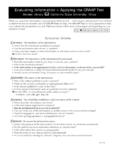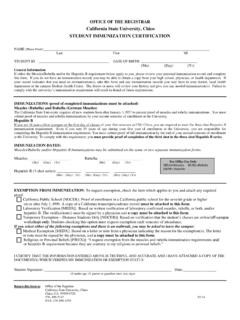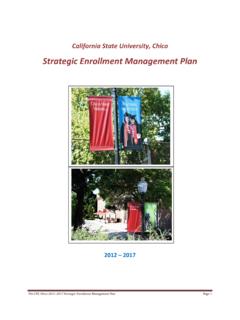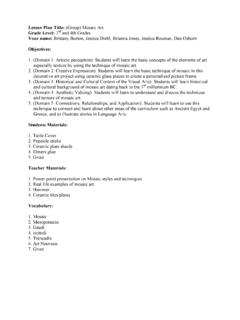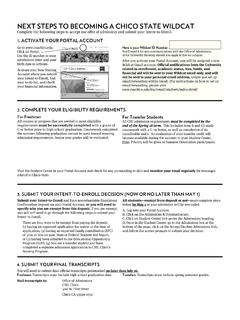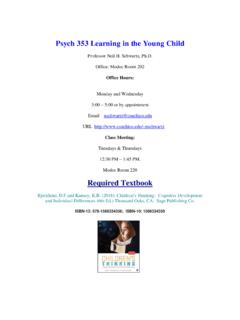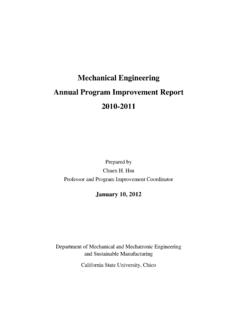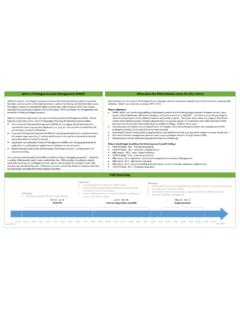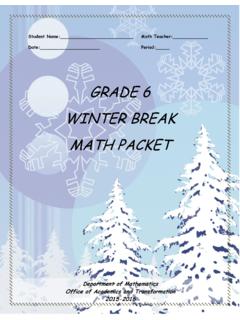Transcription of Lab Activity on the Causes of the Seasons - CSU, …
1 Lab Activity on the Causes of the Seasons 2002 Ann Bykerk-Kauffman, Dept. of Geological and Environmental Sciences, California State University, Chico**Supported by NSF Grant #9455371. Permission is granted to reproduce this material for classroom 35 ObjectivesWhen you have completed this lab you should be able to show how the tilt of Earth s axis andEarth s revolution around the sun Causes seasonal variations temperature day length height of the noonday sunLab Activity #1:Eliciting Your Understanding of the Causes of the SeasonsIntroduction: We have just figured out why the equator is warmer than the poles. But, as you wellknow, our weather is not the same all year round. It is warmer in the summer than inthe winter.
2 The purpose of this Activity is for you to realize exactly what you know(or at least what you think) about the Causes of the : glowing light bulb (to represent the sun )Polystyrene ball with a stick through it (the stick represents Earth's axis) Activity :Within your group, take turns expressing your ideas about the Causes of the the lamp and small globe as props for your explanations. Don't try to be correct; try to express what you REALLY believe. One piece of IMPORTANT information: Earth and all the other planets orbit the sun in a flat plane; Earth is neversignificantly above or below the level of the sun. Keep this in mind when youdemonstrate your ideas; as you demonstrate Earth's orbit, keep the model Earth atthe same height as the model sun (the light bulb).
3 Questions: Try to reach consensus within your group and construct a new group model thatexplains Earth's Seasons . Describe and illustrate this model 36 Lab Activity on the Causes of the SeasonsLab Activity #2: Testing, Refining and Applying Your Modelof the Causes of the SeasonsIntroduction: Part of the scientific process is to constantly test models to see if they can account forall observations. If they do not, we modify them. During this Activity , you will betesting your model and modifying it (or starting over) as necessary in order toaccount for all the observations listed :Glowing light bulb (to represent the sun )Polystyrene ball with a stick through it (the stick represents Earth's axis) Activity :For each observation below, use the materials above to explain the cause of eachobservation.
4 If your model is not compatible with a particular observation, refine, add toor change your model as Shape of Earth's Orbital Path: The table on p. 1 of this lab noted the average distance ofEarth from the sun. The actual distance varies during the year because Earth's orbit isn'tperfectly circular1. The table below provides Earth's average distance from the sun duringselected months of the Earth-Sun Distance3 January147,000,000 kmMarch149,000,000 kmJune153,000,000 kmJuly153,000,000 kmSeptember150,000,000 kmDecember148,000,000 is Earth closest to the sun? When is Earth farthest from the sun? the distance between Earth and the sun account for the Seasons ?
5 Explain the reasoning behind your answer. 1 Note : Earth's orbit around the sun is nearly a perfect circle; it is off by only 4%. Astronomers have calculated theresulting difference in incoming solar radiation: it is only 7%.2 For those who are curious, astronomers calculate these distances from the size of the sun as seen from Earth(objects look bigger when they're closer and smaller when they're farther away).3 Source : Fraknoi, A. (ed.), 1995, The Universe at Your Fingertips: An Astronomy Activity and ResourceNotebook: San Francisco, Astronomical Society of the Pacific. This is an EXCELLENT resource for Activity on the Causes of the SeasonsC North Star Stands Still: At any particular latitude of the northern hemisphere, the north staris always in the same place in the sky (always straight north, always the same distance from thehorizon); no matter what time of day you look or what day of the year it your current working model predict this result?
6 If so, use the polystyrene ball and thelight to show how your model explains why the north star stands still. If your group modeldoes not predict this result, construct a new model that does and describe how this new modelcan explain why the North Star stands of the Seasons in the Northern and Southern Hemispheres: When it is summer inCalifornia (northern hemisphere), it is winter in Argentina (southern hemisphere) and visa your current working model predict this result? If so, use the polystyrene ball and thelight to show how your model explains why summer and winter are reversed in the northern andsouthern hemispheres. If your group model does not predict this result, construct a new modelthat does and describe how this new model can explain why the North Star stands 38 Lab Activity on the Causes of the of Days and Nights At the equator, where it is almost always warm, days and nights each last exactly 12 hours allyear round.
7 Everywhere other than the equator, days are longer in summer than in winter. The longest dayfor us in the northern hemisphere is on the summer solstice (around June 21); the longest dayfor the southern hemisphere is on the winter solstice (around December 21). For example, inChico the days are almost 15 hours long on June 21, but they are less than 9 1/2 hours longon December 21. The closer you get to the poles, the more pronounced this difference is. Forexample, in Anchorage, Alaska, the days are 18 1/2 hours long on June 21, but they are only 51/2 hours long on December 21. At the north pole, it is dark from the autumnal equinox (around September 21) through thevernal equinox (around March 21) and light from the vernal equinox to the autumnal it is light at the north pole, it is dark at the south pole and visa versa.
8 At all locations on Earth other than the poles, there are exactly 12 hours between sunrise andsunset on the dates of the :Draw a dot on your polystyrene ball to represent Chico. Place the polystyrene ball inthe appropriate positions relative to the light to represent the solstices and that you can easily see the circle of illumination (the line between day andnight) on the ball. At each position, spin the ball on its axis to model Earth's how long Chico is in the light and how long it is in the dark at each :1. Can your model for the cause of the Seasons predict this change in the length of the daywith the Seasons ? If so, explain how. If not, refine your model as needed so that it will predict the changes described the change in the # of hours of daylight over the course of a year help (it doesn't haveto be the only factor) explain the differences in temperature between summer and winter?
9 Ifso, explain how. If not, explain why Activity on the Causes of the SeasonsC of the Tropics of Cancer and Capricorn: At North latitude (the Tropic of Cancer), the sun is directly overhead at noon on thesummer solstice (around June 21). At South latitude (the Tropic of Capricorn), the sun is directly overhead at noon on thewinter solstice (around December 21). Activity :Draw two circles on your polystyrene ball in the appropriate positions to representthe Tropic of Cancer and the Tropic of Capricorn. Place the polystyrene ball in theappropriate positions relative to the light to represent the summer and : What is special about the Tropics of Cancer and Capricorn at the solstices that canaccount for the above observations?
10 Use your model for the Seasons to explain 40 Lab Activity on the Causes of the of the Arctic and Antarctic Circles: At North latitude (the Arctic Circle), the sun never sets on the summer solstice (aroundJune 21); on all other days, the sun does go down at least for a little while. Everywhere northof the Arctic Circle, there are even more days when the sun never sets in the summer (thefurther north you go, the more days there are with 24 hours of light-- Midnight Sun ). At North latitude (the Arctic Circle), the sun never rises on the winter solstice (aroundDecember 21); on all other days, the sun does make an appearance. Everywhere north of theArctic Circle, there are even more winter days when the sun never rises (the further north yougo, the more days there are with 24 hours of darkness).
